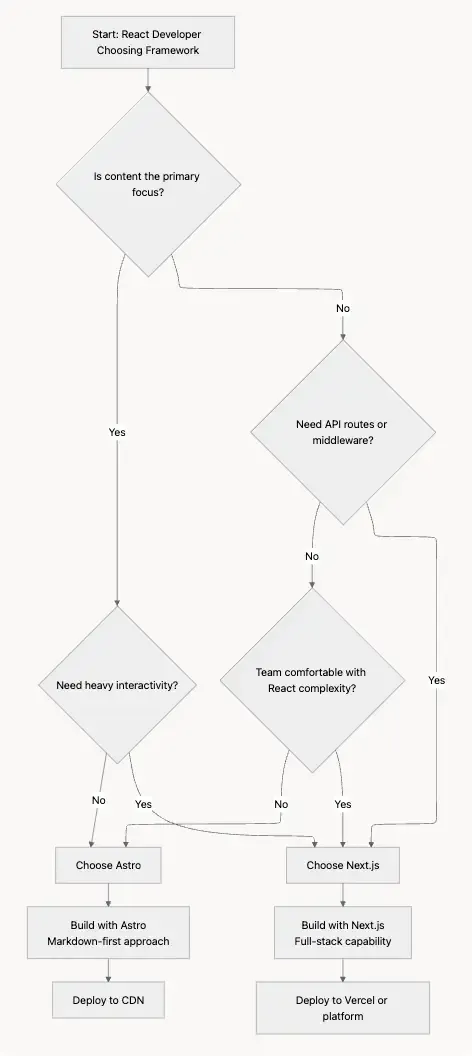React developers face an increasingly complex choice in 2025. Astro vs Next.js comparison is also one of the hottest debate in developer community. Astro achieves near-zero JavaScript by default, while Next.js ships more JavaScript but provides richer features for complex applications. Both frameworks let you write React components. Both have excellent developer experiences. So, which framework is better?
Actually, they excel at different use cases. This comparison will help you make an informed decision in 2025. We'll analyze performance metrics, developer experience trade-offs, ecosystem maturity, and real-world adoption patterns.
By the end, you'll have a clear framework for choosing the right tool for your next project.
Astro vs Next.js Overview
Astro
Astro is a content-first web framework emphasizing minimal JavaScript delivery. It uses a unique "islands architecture" approach. Astro was released in 2021 by the team behind Snowpack. The framework prioritizes performance by shipping zero JavaScript by default. Developers explicitly add interactivity only where needed.
The philosophy is simple: send less JavaScript, get better performance. Astro generates static HTML at build time. It only adds interactive JavaScript when you request it. This fundamentally differs from frameworks that ship JavaScript by default.
Core Features:
Astro's architecture centers on minimal client-side JavaScript:
- Islands Architecture: Hydrate only interactive components, not entire pages.
- Zero-JS by Default: Sends lightweight HTML, CSS, and minimal JavaScript.
- Multi-Framework Support: Write components in React, Vue, Svelte, or Astro's own syntax.
- Markdown-Centric: Optimized for content-heavy sites with frontmatter support.
- Content Collections: Type-safe content management for markdown files.
- View Transitions: Smooth page transitions without full page reloads.
These features work together to achieve exceptional Core Web Vitals scores. Lighthouse consistently rates Astro sites at 98-100 performance scores.
Companies like GitHub, Smashing Magazine, and Firebase use Astro in production.
- GitHub chose Astro for github.dev documentation.
- Smashing Magazine migrated from WordPress to Astro.
- Firebase uses it for developer documentation.
They all report dramatic performance improvements.
>> Explore more: Astro React Integration: Migrate a React SPA for 60% Faster Loads
Next.js
Next.js is a full-featured React framework for building production web applications. Vercel launched it in 2016. It has grown into the dominant React framework. Today, Next.js enjoys massive enterprise adoption. It provides comprehensive features for server-side rendering, static site generation, and API development.
The framework offers an opinionated, battery-included approach to React development. It handles routing, data fetching, and optimization automatically. Next.js 14 (released in 2023) introduced the App Router as the default. This shifted from the Pages Router that dominated earlier versions.
>> Explore further: What are New Features in Next.js 15? Next.js 15 Upgrade Guide
Core Features:
Next.js provides seven critical features for React developers:
- Server-Side Rendering (SSR): Pre-render pages on each request for dynamic content.
- Static Site Generation (SSG): Generate static HTML at build time for performance.
- API Routes: Build backend endpoints alongside your frontend code in
/apidirectory. - File-based Routing: Automatically create routes from files in the
apporpagesdirectory. - Image Optimization: Automatic image optimization with the
next/imagecomponent. - Middleware Support: Intercept requests before they reach your application.
- Edge Runtime: Deploy to edge locations worldwide via Vercel Edge Network.
These features combine to create a full-stack development environment. You can build entire applications without managing separate servers.
>> Read more: Optimize Next.js E-commerce Sites for Better SEO and Performance
Companies like Netflix, TikTok, and IBM use Next.js in production.
Astro vs Next.js: Head-to-Head Comparison
Dimension | Astro | Next.js | Winner |
|---|---|---|---|
| Initial Load Performance | 0-5KB JS shipped, instant HTML | 50-150KB JS typical, SSR overhead | Astro |
| Developer Experience | Simpler learning curve, content-first | Richer features, complex setup | Next.js (depth) |
| Ecosystem & Community | Growing fast, smaller community | Massive adoption, extensive resources | Next.js |
| Full-Stack Capabilities | Limited (recommends external APIs) | API routes, middleware, integrated | Next.js |
| Content Management | Built for markdown, type-safe collections | Flexible but requires additional setup | Astro |
| Dynamic Routing | Static-first, limited dynamic features | Full dynamic routing, SSR built-in | Next.js |
| Deployment Complexity | Simple CDN deployment | Easy on Vercel, complex elsewhere | Astro (simplicity) |
Static Content Performance
Astro achieves exceptional performance compared to Next.js by avoiding most JavaScript entirely. The framework generates pure HTML at build time. It only adds JavaScript when components need interactivity. This fundamental difference creates measurable performance gains.
Here's an example showing Astro vs Next.js performance:
- Astro:
// Astro: Zero JavaScript by default for content pages
---
// src/pages/blog/posts.astro
import BlogPost from '../components/BlogPost.astro';
const posts = await Astro.glob('../content/posts/*.md');
---
<html>
<body>
{posts.map(post => (
<BlogPost post={post} />
))}
</body>
</html>This Astro page generates pure HTML output. The build process renders all blog posts as static HTML. Zero JavaScript ships to the browser.
- Next.js:
// Next.js: Client components hydrate by default
'use client';
import { useState } from 'react';
export default function BlogPost({ post }) {
const [isLiked, setIsLiked] = useState(false);
return (
<div>
<h1>{post.title}</h1>
<button onClick={() => setIsLiked(!isLiked)}>
{isLiked ? '❤️' : '🤍'}
</button>
</div>
);
}This Next.js component ships HTML plus a React hydration bundle. Even without explicit client features, Next.js sends JavaScript for hydration. The React runtime adds 85KB minimum to every page.
Performance Impact: A typical content site with 100 posts renders in under 50KB with Astro versus 200KB+ with Next.js. The difference compounds with more pages and components. Mobile users on slow connections notice immediately.
Lighthouse Scores: Content-Heavy Site
Benchmark tests on a 100-page blog show clear patterns.
Astro Results | Next.js Results |
|
|
You can see, the 17x bundle size difference surely impacts real users.
Enterprise Application Performance
Astro’s zero-JS advantage fades as soon as you add interactivity. Each “island” requires its own hydration directive, and heavy client features accumulate quickly. In contrast, Next.js performs better for interactive, application-style workloads.
- Astro struggles with complex interactivity:
// Adding interactive features requires explicit client directives
---
// src/components/InteractiveButton.astro
---
<button data-client:load>
Click Me
</button>Each interactive element adds JavaScript, diminishing the zero-JS advantage.
- Next.js handles interactivity seamlessly:
'use client';
export default function Dashboard() {
const [data, setData] = useState(null);
useEffect(() => {
fetch('/api/dashboard')
.then(res => res.json())
.then(setData);
}, []);
return <div>{data && <Chart data={data} />}</div>;
}For applications with significant interactivity, Next.js provides better performance through optimized React patterns and server components.
Developer Experience
Astro prioritizes toward a simpler, content-first workflow. Developers like that it doesn’t ask for much setup, and working with Markdown plus frontmatter feels familiar right away. Interactive parts only load when you need them, so you avoid most of the hydration complexity. Overall, there’s less to learn, which makes it easy for teams to get productive quickly.
Next.js provides depth and flexibility instead. It gives you more power and more ways to build things, from flexible routing to server and client components to middleware for handling tricky request flows. There’s also a huge ecosystem of plugins and tools when you need to extend your app. The trade-off is that it takes more time to fully understand, and the learning curve is steeper compared to Astro.
Both approaches work well, but they target different developer needs. Astro appeals to developers valuing simplicity and performance. Next.js suits teams building complex, dynamic applications. Your team's expertise and project complexity determine the better fit.
Ecosystem Maturity
Astro grows rapidly but remains smaller in comparison. The community is active, the plugin landscape is expanding, and tools like MDX, Tailwind, and various CMS integrations are well-supported. But, documentation isn’t as deep, and the talent pool is narrower, which can make hiring or troubleshooting a bit harder.
Next.js, on the other hand, has been around much longer and it shows. With 70,000+ GitHub stars compared to Astro's 40,000+, and adoption from major companies like Netflix, TikTok, and IBM, it has a massive community behind it. Documentation is extensive, tutorials are everywhere, and the Vercel ecosystem makes deployment and optimization feel seamless. Plugins and integrations cover almost any requirement you can think of.
Code Examples: Building a Blog
Let's compare how each framework handles a common scenario:
Astro:
---
// src/pages/blog/posts/[slug].astro
import Layout from '../../components/Layout.astro';
import { getCollection } from 'astro:content';
// Fetch all blog posts
export async function getStaticPaths() {
const blogPosts = await getCollection('blog');
return blogPosts.map((post) => ({
params: { slug: post.slug },
props: { post },
}));
}
const { post } = Astro.props;
---
<Layout title={post.data.title}>
<article>
<h1>{post.data.title}</h1>
<p>Published: {post.data.pubDate.toLocaleDateString()}</p>
<Content />
</article>
</Layout>
<style>
article {
max-width: 800px;
margin: 0 auto;
padding: 2rem;
}
</style>Next.js:
// app/blog/[slug]/page.tsx
import { Metadata } from 'next';
import { allPosts, Post } from 'contentlayer/generated';
export async function generateStaticParams() {
return allPosts.map((post) => ({
slug: post.slug,
}));
}
export async function generateMetadata({
params
}: {
params: { slug: string }
}): Promise<Metadata> {
const post = allPosts.find((p) => p.slug === params.slug);
if (!post) return {};
return {
title: post.title,
description: post.description,
};
}
export default async function BlogPost({
params
}: {
params: { slug: string }
}) {
const post = allPosts.find((p) => p.slug === params.slug);
if (!post) return <div>Post not found</div>;
return (
<article className="max-w-3xl mx-auto p-8">
<h1 className="text-4xl font-bold">{post.title}</h1>
<p>Published: {post.publishedAt}</p>
<div dangerouslySetInnerHTML={{ __html: post.body.html }} />
</article>
);
}
From the code examples above, we can see:
Feature | Astro | Next.js |
|---|---|---|
| Lines of Code | ~25 lines | ~35 lines |
| JavaScript Shipped | 0 KB | 45 KB |
| Runtime Configuration | Simple | More complex |
| Type Safety | Yes | Yes (with contentlayer) |
| Build Time | Faster | Slower |
| Hydration | None | React hydration |
Pros and Cons
| Astro | Next.js |
Pros |
|
|
Cons | Limited Dynamic Features:
Team Considerations:
| Higher JavaScript Bundle:
Learning Curve:
|
Tools and Integrations
| Astro | Next.js |
| Content Management |
|
|
| Styling Options | Supports any CSS solution.
| Tailwind CSS optimized.
|
Hosting Cost And Deployment
Astro:
- Static hosting via Netlify, Cloudflare Pages, or Vercel.
- Generous free tiers support substantial traffic.
- CDN distribution is simple and cost-effective.
- Example: Host 10,000 pages on Cloudflare Pages for $0/month.
Next.js:
- Vercel deployment: Optimized experience, free tier limited.
- Self-hosted: Requires Node.js runtime (higher costs).
- Edge functions and SSR have runtime costs.
- Example: Production Next.js app on Vercel $20-100/month depending on traffic.
Astro is cheaper for static content. Next.js adds runtime costs for dynamic features.
When To Choose Astro vs Next.js?
Choose Astro when building content-first sites like:
- Documentation Sites: Technical documentation, API references, knowledge bases.
- Blogs and Articles: Personal blogs, company blogs, news sites with many articles.
- Marketing Pages: Landing pages, product marketing, company websites.
- Portfolio Sites: Developer portfolios, designer showcases, simple e-commerce pages.
- Content-Heavy Applications: When content volume exceeds interactivity needs.
Choose Next.js when building interactive applications like:
- E-Commerce Platforms: Product pages, shopping carts, checkout flows.
- SaaS Applications: Dashboards, admin panels, data visualization.
- Social Applications: User feeds, real-time updates, interactive UIs.
- Full-Stack Applications: When you need API routes and database integration.
- Enterprise Applications: Complex requirements benefiting from rich ecosystem.
Astro vs Next.js: How to Choose the Suitable One?
Use this decision tree to guide your framework selection:
flowchart TD
A[Start: React Developer Choosing Framework] --> B{Is content the primary focus?}
B -->|Yes| C{Need heavy interactivity?}
B -->|No| F{Need API routes or middleware?}
C -->|No| D[Choose Astro]
C -->|Yes| E[Choose Next.js]
F -->|Yes| E
F -->|No| G{Team comfortable with React complexity?}
G -->|Yes| E
G -->|No| D
D --> H[Build with Astro<br/>Markdown-first approach]
E --> I[Build with Next.js<br/>Full-stack capability]
H --> J[Deploy to CDN]
I --> K[Deploy to Vercel or platform]
Key Questions to Ask:
- "Is content the primary feature?"
- Yes: Astro likely better fit.
- No: Continue evaluation.
- "Do I need dynamic server capabilities?"
- API routes needed: Next.js.
- Static content only: Astro.
- "What's my team's React expertise?"
- New to React: Start with Astro's simplicity.
- Experienced: Next.js unlocks advanced patterns.
- "What's my performance budget?"
- Critical (e.g., marketing): Astro's zero-JS approach wins.
- Flexible (e.g., internal tools): Next.js acceptable.
- "What's the scale trajectory?"
- Thousands of static pages: Astro handles this efficiently.
- Complex application growth: Next.js ecosystem supports scale.
Migration Considerations
Migrating From Next.js to Astro
Motivations: Better performance for content-heavy sites, simpler architecture, lower hosting costs.
Challenges:
- Lose API routes (need to migrate to external services).
- Replace dynamic routing with static file generation.
- Handle client-side interactivity differently (islands approach).
- Smaller ecosystem may require custom solutions.
Effort: Medium to High depending on dynamic features.
Migrating From Astro to Next.js
Motivations: Need for API routes, complex interactivity, team familiar with Next.js.
Challenges:
- Accept larger JavaScript bundles.
- Implement more complex routing patterns.
- Learn server/client component boundaries.
- Manage hydration performance.
Effort: Medium - Astro components translate well to Next.js.
Conclusion
The choice between Astro vs Next.js isn't about which framework is "better." It's about matching the framework to your project's characteristics. Each tool excels in different scenarios. Your job is selecting the right tool for your specific needs.
Otherwise, consider a hybrid strategy when it makes sense. Use Astro for marketing pages and Next.js for the application, which maximizes strengths of each framework. You maintain performance while gaining functionality. Actually, many companies successfully use this approach.
>>> Follow and Contact Relia Software for more information!
- coding
- Web application Development

